Planting shrubs or trees in regular spacing to form a continuous screen is called a hedge. You can use a garden hedge to mark the boundary of your property, keep out intruders, protect your privacy, and reduce traffic noise and pollution. Also, a hedge serves as a windbreak, especially in windswept areas, a partition between garden sections with different functions, a shaded shelter, and a screen for keeping certain areas out of view, such as a vegetable patch, composter, recycling bin, etc.
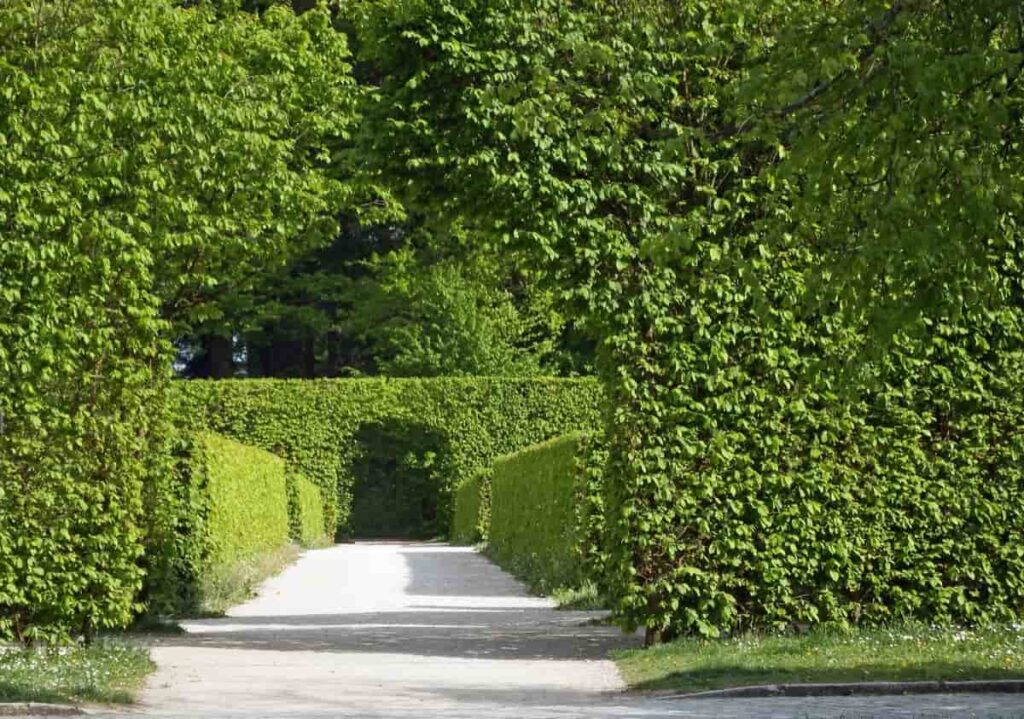
A hedge not only provides all these benefits, but it also looks much more attractive than a wooden fence or wire mesh. Furthermore, living hedges are a haven for biodiversity (insects and other animals), which benefits both gardens and vegetable patches.
How to grow evergreen Hedge plants
Which evergreen Hedge plants should you choose?
Evergreen trees and shrubs do not shed their leaves in autumn, unlike deciduous trees. That doesn’t mean they keep their leaves forever; rather, they fall gradually every 3-6 years, according to the species. You can create a garden hedge consisting of a single plant species from various shrubs available in your local garden center.
Choose those that will produce an evergreen hedge from the following types and bloom for a certain period. The most common evergreen hedge plants include broad-leaved species such as cherry laurel and boxwood and conifers with needle-like or flat leaves like yew and Thuja.
Holly Hedge
Approximately 400 species of flowering plants are found in the genus Holly or Ilex. Hedge like this one, reminiscent of Christmas, needs little pruning and is low-maintenance. The leaves of these plants are prickly, making them a good option for hedging to keep people out of certain areas of the yard. Silver Holly, English Holly, and Japanese Holly are some holly hedge plants.
Box Hedge or boxwood Hedge
Low-maintenance hedges such as box hedges or Buxus are also good options. Approximately 70 species of Buxus exist, most of which are slow-growing. Tropical and subtropical climates are ideal for Buxus hedge species, and frost-tolerant varieties are available. Another great thing about boxwood hedges is that they are easy to maintain and can be pruned formally, even as round hedges. In both upright and round forms, dwarf varieties are also frost-resistant.
In case you missed it: Backyard Gardening Basics: Tips and Ideas What Every Gardener Should Know
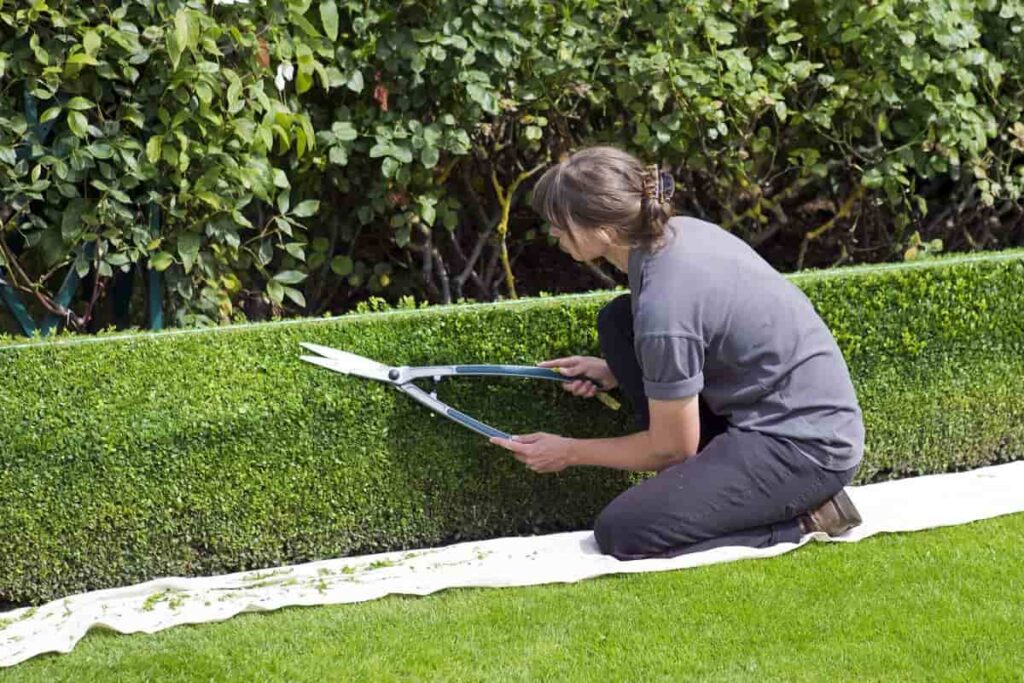
Choisya Ternata Hedge
A low-maintenance and decorative hedge, Choisya ternata is also known as Mexican Orange or Mexican Orange Blossom. White blooms cover this fragrant perennial that grows to about 6 feet tall and 6 feet wide. Mexican orange blossoms, like most citrus, do not tolerate freezing temperatures and are best suited to temperate, tropical climates.
Hornbeam Hedge
The hornbeam is a good choice if you prefer interesting foliage over flowers in your Hedge. The leaves of the hornbeam are corrugated and have serrated margins. In summer, they are bright and green, and in autumn and winter, they turn golden or rust-colored. The Asian hornbeam genus consists of 25 species that are ideal for low-maintenance hedges. Generally, Asian hornbeams reach about 30 feet, especially Korean and Japanese trees. The hedges can be trimmed to maintain a smaller size to serve as screening hedges.
Callistemon Hedge
Callistemon, or bottlebrush, is native to Australia and can also be cultivated in temperate climates worldwide. It resembles a bottlebrush in its blooms, which is why it is called a bottlebrush. The Callistemon flower spikes are mostly red, but some varieties are purple, pink, yellow, white, or green. Because of its nectar, the bottlebrush is a low-maintenance hedge that attracts birds and insects.
Leylandii
The Leylandii hedge plant is a popular choice for those looking for a good hedge height on a small budget who recognize its superb attributes. With regular clipping during midsummer and autumn, Cupressocyparis leylandii can become a magnificent, dense, formal garden hedge ideal for windbreaks, noise reductions, and privacy.
Optimal conditions may result in a growth rate of 90 cm per annum for Leylandii, the fastest-growing of all conifers. As a result, it can grow very tall, so it’s important to keep it to a reasonable height for ease of maintenance. Despite this, Leylandii hedges can easily be trimmed to a height of 5 to 6 feet by doing the regular trimming.
Hawthorn Hedge
Hawthorn blossoms in spring and produces green leaves until its red fruits, known as haws, appear in autumn. Additionally, Hawthorn’s sharp thorns make it an excellent barrier around gardens. Over 150 species of insects and birds are found in hawthorn hedging, making it a wonderful habitat for wildlife. Butterflies and bees are frequent spring visitors, and thrushes, blackbirds, and yellowhammers feed on the red, shiny haws in the autumn. In addition, Hawthorn’s dense, thorny leaves provide a safe nesting site for birds and shelter for small mammals from predators.
In case you missed it: How to Design a Bamboo Garden: Ideas for Layout and Planting from Cuttings
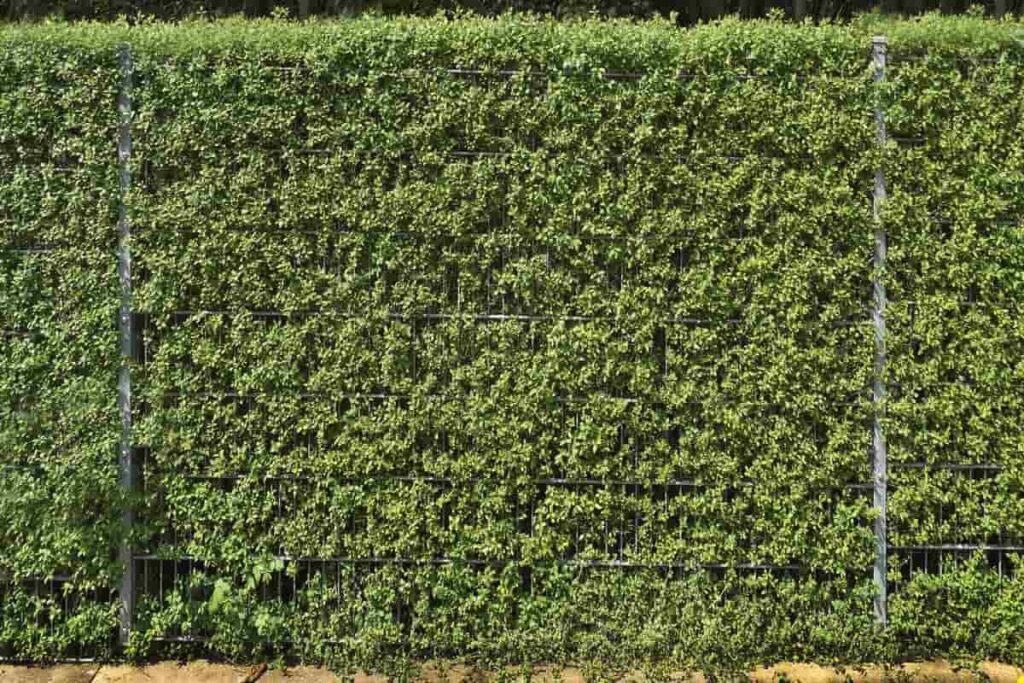
Oleaster Hedge
Oleaster, sometimes called Silverberry, produces subtly fragrant white flowers in autumn and small orange fruits in spring. Leaf undersides are silver-colored with silver speckles, which look stunning when the wind blows the leaves to expose them. Approximately 30 to 50 cm of growth can be expected annually, and it should be clipped in autumn to maintain its shape. Despite being a sturdy evergreen shrub, it is not suitable for cold, wet, or alkaline conditions. However, it thrives in shady, dry, seaside, or windy areas.
Dragon head bamboo
Unlike other bamboo species, Dragon Head Bamboo is bushy from top to bottom with a weeping habit, making it ideal for an evergreen screen. A rusty red casing surrounds its green and thin stems. Many gardens prefer it since it is less aggressive than most bamboo species and has denser foliage.
Common or cherry laurel Hedge
The foliage of these hedging plants is primarily known for its striking, rich green color. In the spring, cherry laurels produce delicate white flowers and red berries throughout the winter. In addition to providing privacy, Cherry Laurel reduces noise and wind because of its density. Cherry laurel hedging grows at a relatively fast rate of 30 to 60 cm per year, making it an economical way to achieve height. Despite its ability to grow to 20 to 30 feet high over time, cherry laurels are easy to maintain at lower heights.
Beech Hedge plants
Even though beech plants are deciduous, their striking winter leaves remain on the Hedge until spring. The year-round interest provided by beech hedging makes it a wonderful alternative to evergreen hedging. In addition, beech hedging is a relatively fast grower; it grows 30-60 cm per year. Plants like these grow well in the sun and shade and thrive in well-drained soil. Nevertheless, beech hedging is not suitable for heavy clay or wet soils.
Western red cedar
In addition to its slightly slower growth rate, Western Red Cedar is an easy-to-maintain alternative to Leylandii for hedging. It produces attractive sprays of glossy mid to dark-green foliage, which is glossier than that of other conifers. In addition to being aromatic, the leaves give off a sweet, fragrant scent when crushed. In contrast to Leylandii, Western Red Cedar can be cut back into old wood without the risk of browning, making it much easier to maintain.
Soil for growing Hedges
Hedge plants should be grown in a sterile potting medium from your garden center. Alternatively, you can mix perlite, vermiculite, and peat moss to create your own. First, make sure the potting medium is well-draining and free of fungi, bacteria, and other organisms that can prevent your hedge-cutting from rooting properly. The next step is to enrich the soil with organic matter or to mix Bonemeal into the soil.
Sunlight requirements for Hedge plants
The burst of color that greets you when you step into the garden is one of the best things about summer. Choose hedges and shrubs that can withstand sunlight exposure. If you choose hedging species that thrive in full sun, you will be rewarded with vibrant foliage color and an abundance of blossoms. Often, hedge plants for sunny sites are drought-tolerant and thrive in hot, dry conditions, but they do not need constant sunlight; 6-8 hours a day is sufficient.
In case you missed it: How to Create a Potager: A Full Guide to French Kitchen Garden
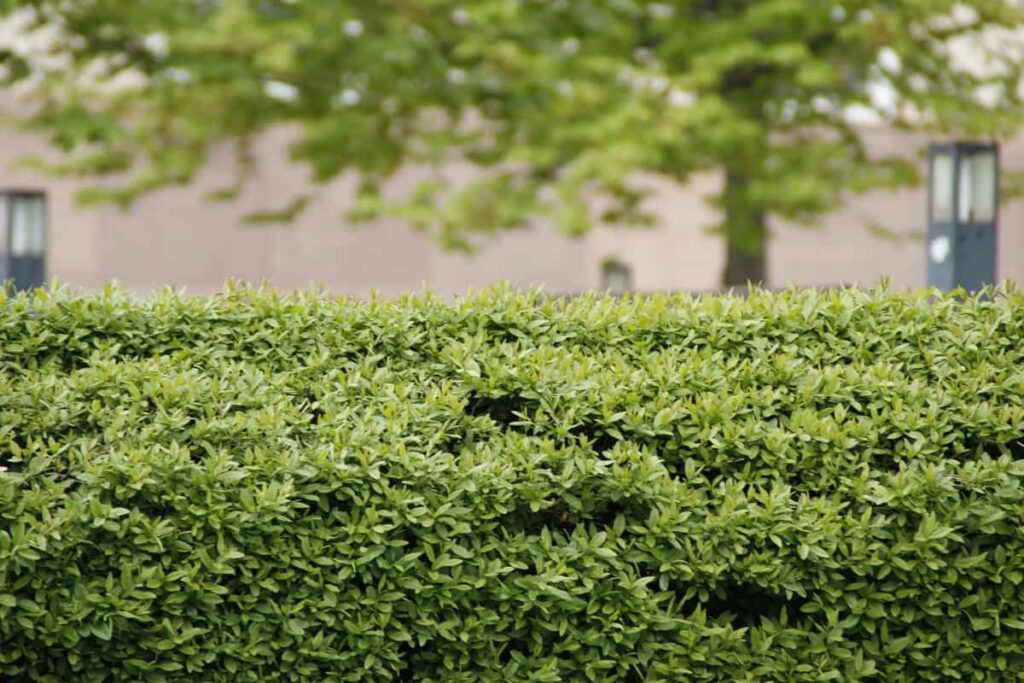
Sometimes a hedge has to cover both a full sun area and a shaded area seamlessly, which is why you need something that can cover both. The best hedges for shade are those that are grown in shady locations. A few more varieties are available in partial shade, but some will tolerate deep shade. Shade-loving hedges include Schip Laurel, Teton Firethorn, Green Giant Arborvitae, European Beech, and Hicks Yew
Growing evergreen hedge plants
- Take a cutting from the Hedge or shrub you wish to propagate. It is important that your Hedge or shrub has an established root system, grows vigorously, and is free of disease and pests.
- Decide where the cutting should be taken. Choose a branch that is a bit mature but has plenty of new growth. Avoid branches thready in full bloom or have alst all their flowers.
- About one-quarter inch below a leaf node, cut with sharp pruning shears at a 45-degree angle.
- Water the newly cut stem cuttings until they are ready to be propagated to keep them hydrated.
- Remove the flowers and buds from the branch. Next, remove the leaves from two to four leaf nodes on the stem covered in potting medium.
- Put a small amount of rooting hormone in a shallow container. Cover the bottom two to three inches of the shrub cutting with rooting hormone, and at least two leaf nodes on the stem should be covered.
- With a stick or dowel, dig a hole in the soil.
- Place the hedge cutting gently in the potting medium and backfill the soil around the cutting.
- It is necessary to keep the cuttings moist until they are rooted. Therefore, a successful rooting of the cuttings depends on it.
- After the cuttings have established roots, they can be planted in your garden or wherever you want to grow your privet hedge.
Hedge plants maintenance and care
When and how to water your hedge plants
While most of our hedges are highly drought-tolerant, they will require regular water for the first few seasons until their roots have been established. Additional water may be required to keep hedges flourishing during extremely hot, dry summers. During the early morning hours of the day, the hedges are watered. It is suggested to water the plants every 2-3 days for 1-2 hours immediately after planting. The water must penetrate deep into the soil.
In case you missed it: Missouri Vegetable Planting Calendar (MO): Month-wise Chart, Schedule, and Guide for Zone 5, Zone 6, and Zone 7
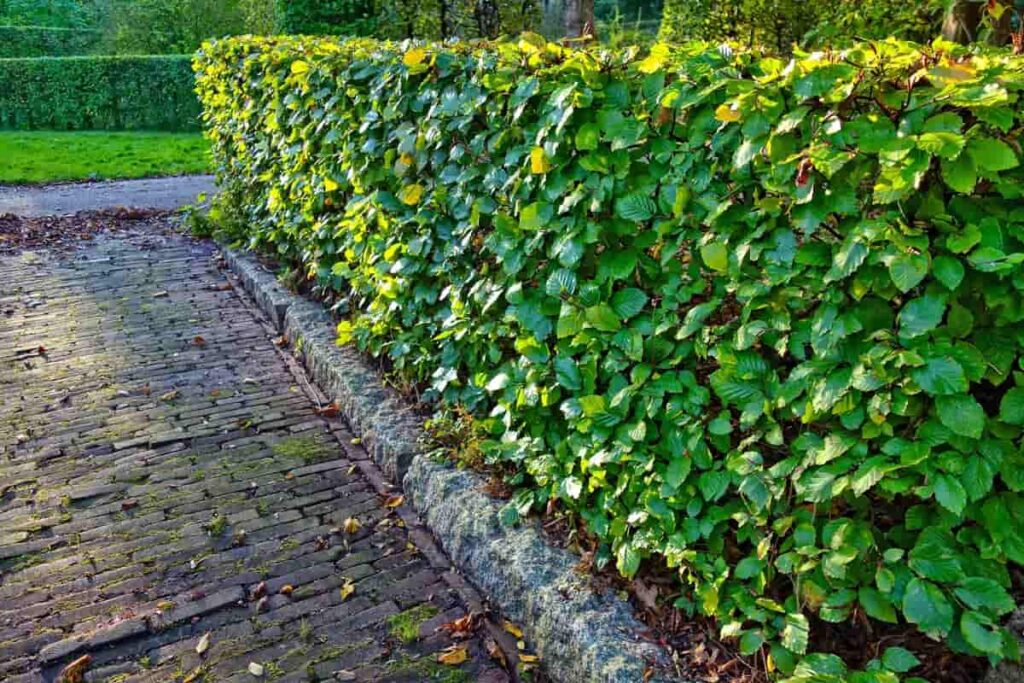
Water will not be retained for a long time in sand soil. It is, therefore, best to water your garden often and in small amounts if it has this type of soil. In contrast, clay soil retains water better than sandy soil because it is heavier. Therefore, saturating the soil requires one abundant watering session, which won’t require more until the following season.
When and how to fertilize your hedge plants
Hedge plants require annual fertilization to maintain their appearance and produce ample foliage, regardless of whether they are deciduous or evergreen. A slow-release phosphorous fertilizer or an organic fertilizer mix can be used to fertilize these hedges. Spring is the best time to fertilize hedges, as the fresh fertilizer will provide the hedges with the energy they need to produce lush foliage.
Fertilizer types and amounts will vary depending on the shrub variety, the Hedge’s age, the shrubs’ spacing, and the growing conditions. A soil test provides accurate information about fertilizing hedges. If hedges are over-fertilized, they will grow excessively, which requires additional pruning and makes them susceptible to cold damage and breakage.
Applying mulch for hedge plants
The growing environment around hedge plants can be improved as well as the plants’ overall appearance, by spreading mulch around them. Water is retained more efficiently in soil when mulch is applied, thus reducing the need for irrigation. In addition, the decay of organic mulch adds nutrients to the soil over time. The mulch also discourages weeds and grasses from growing, reducing the need for weeding or pulling, especially in hard-to-reach areas like under hedges.
As soon as the frost has over and the soil has begun to warm, mulch should be applied under hedges. Mulch can be spread under hedges using a pitchfork, hay fork, garden shovel, or even by hand if you’re wearing gloves. It is recommended that the mulch layer is about 4 inches deep. To prevent bark decay, remove the mulch about 1 to 2 inches from the base of each plant. The mulch should then be spread to the outside edge of the foliage or at least 3 feet away from the base of the plant.
Pruning of Hedge plants
Plant walls need to be pruned regularly, whether they are privacy hedges or landscape hedges. Trees and shrubs can maintain a harmonious shape and have beautiful flowers in the spring and summer. However, new hedges require formative pruning for the first couple of years after planting. This formative pruning is usually carried out in the winter or early spring.
Afterward, maintenance trimming is carried out twice a year for informal hedges and once a year for formal hedges. Therefore, it may be necessary to cut formal hedges three times a year. In general, maintenance trimming is done during the spring and summer months.
Pests and diseases in Hedge plants
Several common hedging diseases can affect the hedging of different types. The primary effect of this disease is discoloration, ruining the visual impact you have worked so hard to achieve. Unfortunately, this can lead to plants dying in some cases. Luckily, most diseases are easy to treat, particularly if you give them a little love and care.
Powdery Mildew
Powdery mildew affects hedging plants with a powdery, gray coating, such as native hawthorn hedges. Almost no hedge is fully immune to this disease, which is quite common. Despite this, the condition can be treated relatively easily. It might be a good idea to spray fungicide on the Hedge.
In case you missed it: How to Build Raised Bed Garden from Scratch: Plan, and Design for Beginners
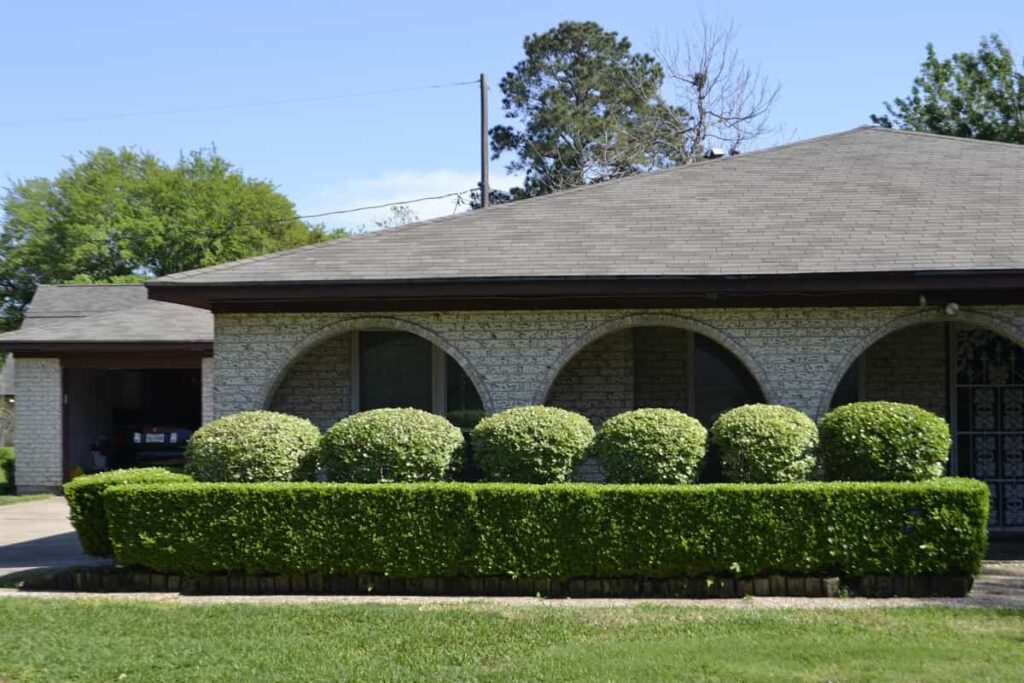
Box Blight
The box blight affects box hedging, as one might expect. Boxwood blight is caused by two strains of fungi, which lie dormant in dead leaves and produce spores as temperatures rise in spring. The prevention of box blight can be achieved by spraying fungicide in early April.
Bronze Foliage
Some types of hedges can end up turning bronze. First and foremost, bronze foliage on yew hedges may result from windburn and other extreme weather conditions, such as hot summers and heavy frosts. In this case, the solution is to leave them alone; they will soon regain their color after the sudden weather changes.
Bronze foliage can develop as a result of root rot. Examining where the bronze foliage is can usually determine whether it is due to root rot. Usually, it begins where the leaf attaches to the stem. It is only possible to improve drainage that will solve the problem.
Conclusion
Growing hedges are a good idea since they keep their leaves all year round instead of shedding them in the autumn or producing new ones in the spring. Furthermore, if appropriately maintained, a live-impregnable hedge reinforced with barbed wire is much cheaper than a boundary wall. Finally, the monsoon season is the best period to plant seeds or cuttings for a new hedge.
- Broccoli Varieties: Choosing the Right Cultivars for Your Farm
- How to Raise Pigs in Your Own Backyard: A Comprehensive Guide
- Budget Friendly Sheep Shed Ideas: Cheap and Low-Cost Tips
- How Much Do Cattle Farmers Make: Revenue Streams in Cattle Farming
- Management Pests and Diseases in Your Cotton Field
- Sheep Farming Business Plan for Beginners
- Aquaponic Farming at Home: A Step-By-Step Guide
- Profitable Village Farming Business Ideas in 2024
- High-Yield Aquaculture: Fast-Growing Fish for Farming
- Effective Fish Pond Construction Techniques for Beginners
- Irrigation and Water Management in Pineapple Farming
- Blossom to Harvest: Mastering Flowering and Pollination in Papaya Farming
- Pig Fattening Essentials: From Selection to Sale for Beginners
- Raising Wagyu Cattle: A Complete Guide for Premium Beef Production
- Soil Types and Their Water Holding Capacity
- Optimizing Irrigation Schedules for Coconut Groves for Enhanced Yield
- Espresso Your Garden: Coffee Grounds for Healthier Acid-Loving Plants
- The Best Soil Mix for Snake Plants: How to Mix Your Own Snake Plant Soil
- Green Thumb Success: Expert Tips for Cultivating Greenhouse Beans All Year Round
- Bloom All Year Round: The Ultimate Guide to Indoor Hyacinth Care
- Eco-Friendly Gardening: How to Make Liquid Fertilizer from Kitchen Waste
- Ultimate Guide to Grow Anise in Pots: Explore Seed Propagation to Harvesting
- Guide to Raising Chester White Pigs: Discover Breed Facts to Growth Management
- Mastering the Elegance: The Ultimate Guide to Weeping Cherry Tree Care, Planting, and Maintenance
- Ultimate Guide to Planting Garlic in Grow Bags: Growing Strategies for Beginners
- How to Fix Spider Plant Leaf-Related Problems: Natural and Organic Remedies
- 10 Reasons Why Your Tulsi Plant is Shedding Leaves: Home Remedies and Solutions
- Optimizing Growth and Yield: The Advantages of Palm Bunch Ash Fertilizer
- Utilizing Neem Oil Extract as a Natural Pesticide for Hydrangea
- From Soil to Harvest: Various Ways in Which Farmers Can Use AI Tools
- Steps to Encourage and Induce Citrus Flowers: A Comprehensive Guide
- How to Fix Snake Plant Leaf-Related Issues: Natural and Organic Remedies
- Transform Your Garden into a Fragrant Oasis with Raat Ki Rani (Night Blooming Jasmine)
- Discover the Ideal Chicken Breeds for Philippine Farms
- How to Create a Poultry Egg Farm Business Plan for Profits
- Grow Lemon Cucumbers Like a Pro: Insider Techniques for Bountiful Yields
